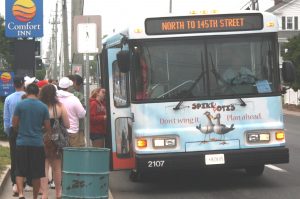
OCEAN CITY — With the help of a major federal grant, all of the municipal buses in Ocean City’s fleet could be outfitted with surveillance cameras inside and out.
At Tuesday’s Transportation Committee meeting, Public Works Director Hal Adkins told members the Maryland Transit Authority (MTA) was considering including a $500,000 investment in a state-of-the-art video and audio surveillance camera system on all of the buses and vehicles in Ocean City’s fleet as part of the agency’s fiscal year 2017 allocation to the resort. Adkins said the offer “came out of left field” and the discussions were only cursory at this time, but the MTA was encouraging Ocean City to accept the offer.
The MTA is recommending Ocean City move forward with implementing a transit surveillance system aboard its entire fleet, which currently includes 65 vehicles including ADA vans. The MTA is recommending as many as five or six cameras inside and out for the standard 40-foot buses and eight or nine cameras for the each of the two new articulating buses. Given the total number of vehicles in the resort’s current fleet, the total number of cameras would be around 400.
The total cost of the project is around $500,000, with the lion’s share coming from the federal government at $400,000. The state would contribute 10 percent, or $50,000, while the local match would also be 10 percent, or $50,000. The high-resolution color cameras would be hardwired into each bus by an independent contractor chosen through a competitive bid process.
Adkins said the implementation would have limited involvement from the town’s Information Technology (IT) staff. The cameras would not stream live surveillance video from the buses to another site and no one would be monitoring the video and audio in real time. Instead, the surveillance video and audio would be stored on each individual bus.
“This is reactive,” he said. “There is nobody sitting behind a monitor watching live surveillance video. This is for lawsuits and police investigations and for training and a variety of other uses.”
City Engineer Terry McGean said storing the video and audio surveillance long term at a remote location could come with some unforeseen costs.
“If it’s localized and stored on the bus itself, it could be saved for a period of time before it overwrites itself,” he said. “Our big issue is, if it goes beyond simply storing the surveillance on the bus and we have to store it somewhere else, there could be financial and storage issues.”
Adkins said the proposed system does not include any long-term storage. The day in, day out footage would be stored for as yet undetermined period of time before the video and audio loops were taped over. If there was an incident on one of the buses inside or out, that piece of audio and video could be saved and stored indefinitely until it was needed.
Councilmember Mary Knight said recording and saving surveillance of incidents on or near the buses could be important because of legal implications.
“Sometimes we get lawsuits three years down the road,” she said. “If we know of an incident, can we store it?”
OCPD Captain Kevin Kirstein said the police department employs a similar system for recording and saving incidents with its surveillance camera system throughout the resort including the Boardwalk.
“That’s what we do at the police department,” he said. “When we have an idea something might be an issue, we pull the footage and store it.”
Risk Manager Eric Lagstrom endorsed the proposed video and audio surveillance system for the resort’s buses. Lagstrom often handles complaints about issues on buses and potential lawsuits for slips and falls, for example.
“I think it would be a great advantage,” he said. “Whether it works for us or against us, we would at least know where we stand.”
After some discussion, it was determined the town’s potential $50,000 investment to leverage the other $450,000 from the federal and state grants was worthwhile considering the potential benefits from video and audio surveillance on the buses. The Transportation Committee decided to forward a favorable recommendation to the Mayor and Council for approval.
Adkins said implementing the surveillance system on the buses would but Ocean City ahead of the curve compared to many public transit systems across the state. He said the best estimate was that 30 to 50 percent of the local operating transit systems, or LOTS, in Maryland currently did not have surveillance systems. Councilman Dennis Dare said investing in the surveillance system for the buses made sense because of the obvious public safety and training benefits.
“Transit systems carry a higher level of responsibility because people entrust us to carry them,” he said.

